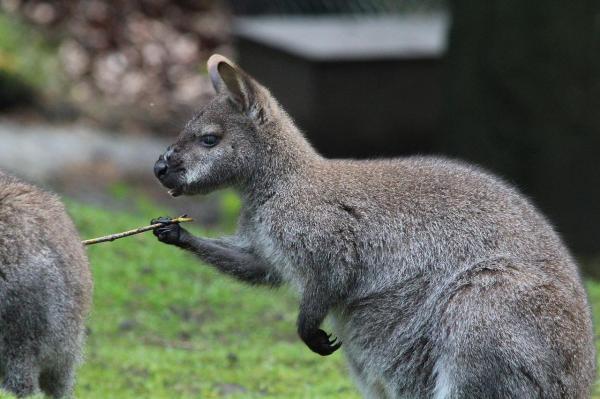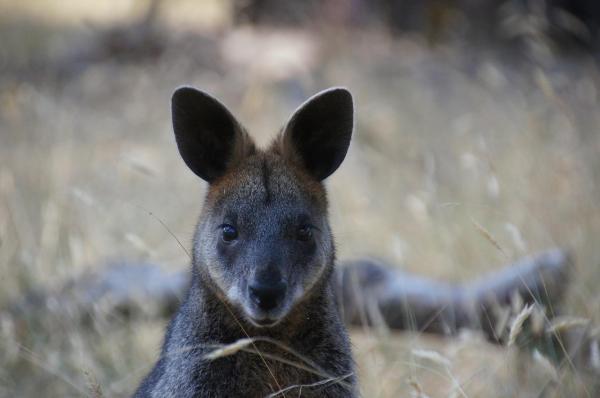
Both the wallaby and the kangaroo are Australian marsupials: after a short period of gestation in the womb, their young complete their development in their mother's abdominal pouch. They cling to the mammary glands for about 9 months until they can venture out of the pouch, with the little ones only returning to the pouch to suckle.
Both the wallaby and the kangaroo belong to the family of macropods: they have over-sized feet that allow them to jump, which is their only way of getting around. Owing to the fact that they live on the same continent and they belong to the same infraclass of marsupials and the same family of macropods, wallabies and kangaroos look very similar. However, there are still important differences between them.
In this AnimalWised article we are going to explain the differences between kangaroos and wallaby.
What is bigger, a kangaroo or a wallaby?
Kangaroos are much larger than wallabies: the red kangaroo (Osphranter rufus) is the world's largest marsupial. The biggest ones are always male and can measure more than 250 cms - 8'2'' - from the tip of the tail to the head, and weigh about 90 kilos - almost 200 pounds.
On the other hand, the largest wallabies are about 180 cm - 5'10'' - at the most and weigh around 20 kilos - 45 pounds. To give you an idea, it is considered that a typical female wallaby weighs around 11 kg - 24 lb - while a typical female kangaroo weighs about 20 kilos - 45 lb.

Differences in legs and habitat
Kangaroo legs are longer in relation to the rest of their body, especially the part from their ankle to their knee, which seems longer and makes them look disproportionate. A kangaroo's long legs allow it to jump quickly in wastelands, usually moving about 20 km/hour (12 m/h), they can even exceed 50 km/hour (31 m/h).
On the other hand, the more compact body of the wallabies allows them to move nimbly through the forest.

Differences in teeth and diet
The wallaby lives in forests and feeds mainly on leaves. As such, it has flattened premolars for crushing and grinding leaves, and their incisors are more pronounced for occasional cutting.
Even though the kangaroo loses its premolars during adulthood and its row of its molars forms a curve, its teeth are grooved and the crowns of its molars are more pronounced. This dental structure allows it to cut the stems of tall grass.

Differences in color
The wallaby is generally more vivid and colorful, with different colored spots. For example, the agile wallaby has streaks of color in its cheeks and at hip level, while the red-necked wallaby has a grey body with white stripes on its upper lip and black legs, with males having a red streak.
Instead, kangaroo fur is usually much more monochrome, with color patterns evenly distributed across their body. Grey kangaroos have darker fur on their bellies and lighter fur on their face.

Differences in reproduction and behaviour
Both species have one offspring - called a "joey" in both cases - per pregnancy. The mother not only carries her child in her pouch until it is weaned, but she actually does so until it is totally independent:
- A young wallaby is weaned at 7-8 months and usually stays in the mother's pouch for one more month . It reaches sexual maturity at 12-14 months.
- A small kangaroo is weaned at 9 months and stays in its mother's pouch until 11 months. It will only be able to reproduce at 20 months.
Both the kangaroo and the wallaby live in small family groups, consisting of a dominant male, his group of females, their young and sometimes an immature submissive male. It is much more common to see wallabies boxing than kangaroos. They usually do so with their partner.

Which live longer, wallabies or kangaroos?
Kangaroos live much longer than wallabies. Kangaroos live for 20-25 years in the wild and 16 to 20 years in captivity, whereas wallabies live for around 11-15 years in the wild and about 10-14 years in captivity. Both species are hunted by humans; kangaroos for their meat and wallabies for their fur.
Discover more at Animal Wised...
- Differences between camels and dromedaries
- Differences between rats and mice
- Differences between crows, ravens and rooks

If you want to read similar articles to Differences between Kangaroos and Wallaby, we recommend you visit our Facts about the animal kingdom category.